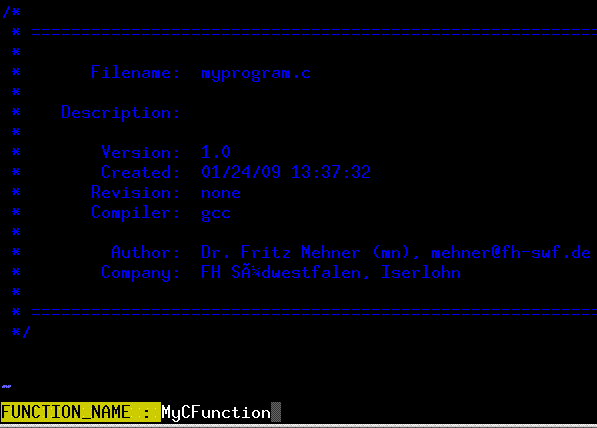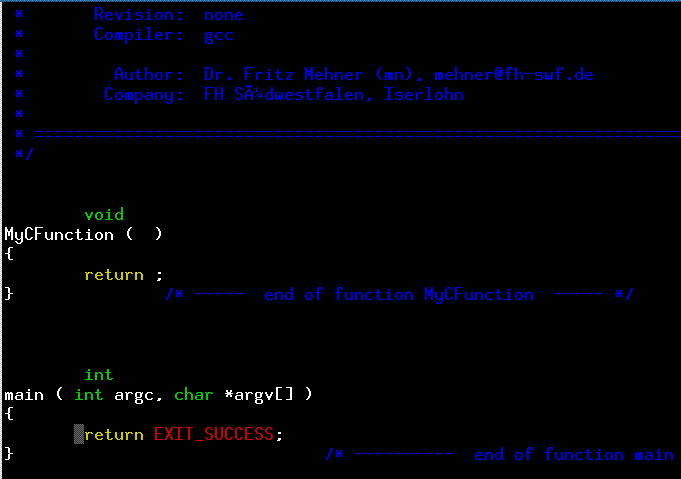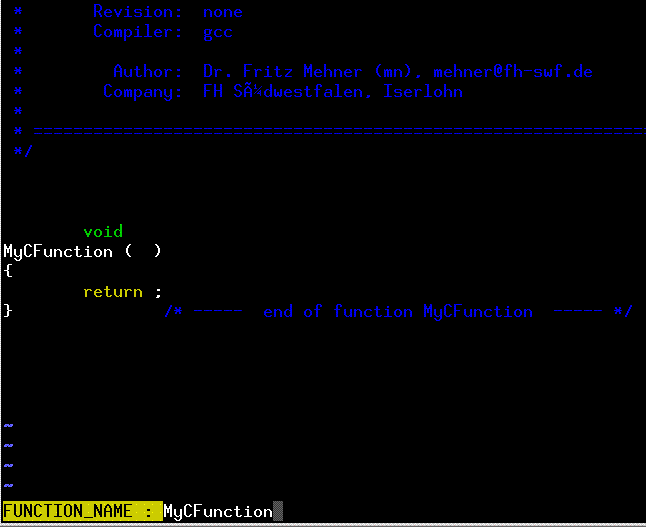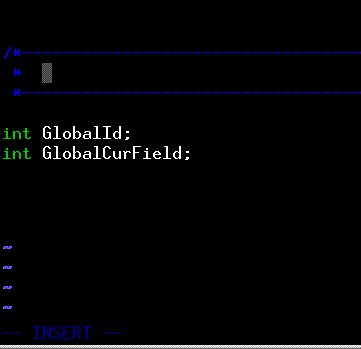This article is part of the ongoing Vi / Vim Tips and TricksSeries. As a programmer, you may do lot of repetitive tasks while coding such as:
- Adding file header
- Adding function/frame comment
- Including default code snippet
- Performing syntax check
- Reading documentation about a function
- Converting a code block to comment, and vice versa
The C-Support Vim Plugin offers easiest way to do all of the above, saving lot of time and keystrokes for C and C++ programmers.
The plugin was written by Fritz Mehner, who explains the purpose of
the plugin as: “Write and run programs. Insert statements, idioms,
comments”.
He also highlights following features:
- Statement oriented editing of C / C++ programs
- Speed up writing new code considerably.
- Write code and comments with a professional appearance from the beginning.
- Use code snippets
This article explains how to install the plugin in 3 easy steps and 7 powerful features of the plugin.
3 Steps to Install the C.Vim Plugin
Step 1: Download C Vim Plugin
Download the plugin from vim.org website.
$ cd /usr/src $ wget http://www.vim.org/scripts/download_script.php?src_id=9679
Step 2: Install the C Vim Plugin
$ mkdir ~/.vim $ cd ~/.vim $ unzip /usr/src/cvim.zip
Step 3: Enable the plugin in the ~/.vimrc
Add the following line to the ~/.vimrc to enable the plugin for Vim editor.
$ vim ~/.vimrc filetype plugin on
8 Powerful Features of C.Vim Plugin
Feature 1: Add Automatic Header to *.c file
When you open a file with the extension .c it opens the file with header as shown below. This will also place the cursor in the Description field in Insert mode.
$ vim myprogram.c /* * ================================================= * Filename: myprogram.c * * Description: * * Version: 1.0 * Created: 01/19/09 20:23:25 * Revision: none * Compiler: gcc * * Author: Dr. Fritz Mehner (mn), mehner@fh-swf.de * Company: FH Südwestfalen, Iserlohn * * ================================================= */
To change the default value of the AUTHOR and COMPANY, modify the default value in ~/.vim/c-support/templates/Templates
$ vim ~/.vim/c-support/templates/Templates |AUTHOR| = geekstuff |AUTHORREF| = gk |EMAIL| = subscribe@geekstuff |COMPANY| = thegeekstuff.com
Now, when you create a new c file, it will show the modified values for AUTHOR and COMPANY as shown below.
$ vim myprogram.c /* * ================================================= * * Filename: myprogram.c * * Description: * * Version: 1.0 * Created: 01/19/09 20:26:43 * Revision: none * Compiler: gcc * * Author: geekstuff (gk), subscribe@geekstuff * Company: thegeekstuff.com * * ================================================= */
Note: To add custom fields to the header, modify the
~/.vim/c-support/templates/file-description.template file and add your
own custom field.
Feature 2: Adding C function using \if
For writing a subroutine, type \if in normal mode, which will prompt
for the function name (as shown in Fig1 below) and inserts the
subroutine with default function content (as shown in Fig2 below).

Fig1:Insert C Function Automatically

Fig 2:Insert C Function Automatically
Feature 3: Insert main Function Header using \im
For inserting main function, type \im in normal mode, which will add the main function as shown below.

Fig 3: Insert C main function automatically
Feature 4: Insert a Function Header using \cfu
For inserting a function header, type \cfu in normal mode, which will
ask the function name as shown in Fig 4, and adds the comment as shown
in Fig 5.

Fig 4: Insert C Function Header Automatically

Fig 5: Insert C Function Header Automatically
Feature 5: Add a Frame comment using \cfr
To add a frame comment, type \cfr in normal mode, which will give the following formatted comment.

Fig 6: Insert a Frame Comment Automatically
Feature 6: To include header file, use \p<
Type \p< in the normal mode, which will include the text “#include <>”, and places the cursor in the < symbol in Insert mode where you can type the header file name.
Feature 7: Save the file, compile it and execute it immediately.
To save and compile the file use \rc.
To run use \rr.
Feature 8: Insert pre-defined code-snippet to the C code using \nr
The plugin comes with few pre-defined code snippets that you can insert into your code. Following are the default code snippets that comes with the plugin.
$ ls ~/.vim/c-support/codesnippets Makefile calloc_double_matrix.c main.c print_double_array.c.noindent Makefile.multi-target.template calloc_int_matrix.c main.cc print_int_array.c.noindent
For example, if you want to create a function that will Allocate a dynamic int-matrix of size rows*columns; return a pointer, you can re-use it from the existing code snippets. Following is the content of the calloc_int_matrix.c pre-defined code snippets.
/*
* === FUNCTION ======================================================================
* Name: calloc_int_matrix
* Description: Allocate a dynamic int-matrix of size rows*columns; return a pointer.
* =====================================================================================
*/
int**
calloc_int_matrix ( int rows, int columns )
{
int i;
int **m;
m = calloc ( rows, sizeof(int*) ); /* allocate pointer array */
assert( m != NULL ); /* abort if allocation failed */
*m = calloc ( rows*columns, sizeof(int) ); /* allocate data array */
assert(*m != NULL ); /* abort if allocation failed */
for ( i=1; i
m[i] = m[i-1] + columns;
return m;
} /* ---------- end of function calloc_int_matrix ---------- */
To insert this into your working c program, type \nr from the normal
mode inside vim, which will prompt “read snippet
/home/ramesh/.vim/c-support/codesnippets/”, type calloc_int_matrix.c at
the end and press enter, which will insert the content of the
~/.vim/c-support/codesnippets/ calloc_int_matrix.c to your working file
automatically.
Note: You can define your own code snippets and place
it under ~/.vim/c-support/codesnippets/. You can also build your own
code snippets from the existing code – select the part of code need to
be made as code snippet, press \nw, and give a file-name to it. From
next time, type \nr and the file-name to get your custom code snippet.
There are lot of powerful features in the C-Support Vim Plugin. Read the
documentation for more information. The documentation is located in the
following location on your system.
- README : ~/.vim/README.csupport
- PDF : ~/.vim/c-support/doc/c-hotkeys.pdf
- Online c-support vim plugin documentation
- This plugin comes with a help file (csupport.txt) which can be viewed by :h csupport
- Additional Screenshots of this plug-in.
Recommended Reading
 Vim 101 Hacks, by Ramesh Natarajan.
I’m a command-line junkie. So, naturally I’m a huge fan of Vi and Vim
editors. Several years back, when I wrote lot of C code on Linux, I used
to read all available Vim editor tips and tricks. Based on my Vim
editor experience, I’ve written Vim 101 Hacks eBook that contains 101
practical examples on various advanced Vim features that will make you
fast and productive in the Vim editor. Even if you’ve been using Vi and
Vim Editors for several years and have not read this book, please do
yourself a favor and read this book. You’ll be amazed with the
capabilities of Vim editor.
Vim 101 Hacks, by Ramesh Natarajan.
I’m a command-line junkie. So, naturally I’m a huge fan of Vi and Vim
editors. Several years back, when I wrote lot of C code on Linux, I used
to read all available Vim editor tips and tricks. Based on my Vim
editor experience, I’ve written Vim 101 Hacks eBook that contains 101
practical examples on various advanced Vim features that will make you
fast and productive in the Vim editor. Even if you’ve been using Vi and
Vim Editors for several years and have not read this book, please do
yourself a favor and read this book. You’ll be amazed with the
capabilities of Vim editor.
Awesome Vim Editor Articles
Following are few awesome Vi / Vim editor tutorials that you might find helpful.
- Convert Vim Editor to Beautiful Source Code Browser for Any Programming Language
- 12 Powerful Find and Replace Examples for Vim Editor
- Vi and Vim Macro Tutorial: How To Record and Play
- Turbocharge Firefox Browser With Vim Editor Functionality Using Vimperator Add-on
Note: Please subscribe to The Geek Stuff and don’t miss any future Vi and Vim editor tips and tricks.